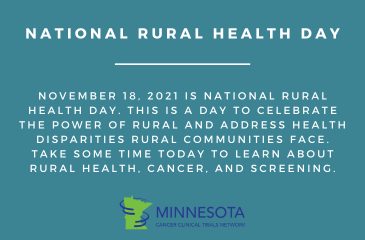National Rural Health Day: Rural Health Disparities and Cancer Screening
National Rural Health Day is celebrated each year on the third Thursday of November in the United States. Initiated by the National Organization of State Offices of Rural Health, National Rural Health Day is a day to celebrate the power of rural communities, engage rural stakeholders, and address unique health care challenges rural communities face. As an organization that focuses on rural communities and cancer research, the Minnesota Cancer Clinical Trials Network (MNCCTN) is committed to addressing and overcoming the health disparities and barriers that rural communities experience.
In Minnesota, 27 percent of the population live in non-metro areas, and 8 percent live in isolated rural areas. On average, rural Minnesotans are older, have lower incomes, must travel farther for health care, and are more likely to have public health insurance compared to urban Minnesotans. While urban areas have larger non-white populations, an exception is American Indian and Alaskan Native populations, which are larger in rural areas in Minnesota.
An important topic that MNCCTN is especially interested in exploring this year and in the future is cancer screening. Cancer screening, looking for cancer before one exhibits symptoms, is one of the most powerful strategies to both prevent cancer and improve health outcomes by detecting cancer as early as possible. Cancer screenings may consist of a physical exam, lab tests, imaging procedures, or genetic tests.
While screening methods and guidelines don’t exist for every type of cancer, there are certain cancers we can test for according to guidelines such as age, certain risk factors, and more. For example, the U.S. Preventive Task Force recommends all people aged 45 to 75 be screened for colorectal cancer at regular intervals, or earlier if people are more at risk due to a family history of colorectal cancer or polyps, certain illnesses such as Crohn’s disease or ulcerative colitis, or a genetic family syndrome. Some of the most common cancers we screen for are colorectal cancer, breast cancer, cervical cancer, and lung cancer.
While the importance of cancer screening and guidelines are well understood, rural communities have lower cancer screening rates compared to urban individuals. Cancer screening rates are even lower for people of color in rural areas. In Minnesota, Hispanic people in rural areas have lower screening rates than other races and ethnicities in rural communities. Some factors that affect screening rates for rural residents, and especially people of color, include education, proximity or access to health care services, and lack of insurance. One study found that 83 percent of urban patients live within 30 minutes of a lung cancer screening center, while only 22 percent of rural patients did. Because of these factors, rural populations have higher incidences of cancers that can be prevented or treated earlier with screening and early intervention, such as colorectal, cervical, and lung cancers.
Surveys have also found that rural adults have more pessimistic and fatalistic views about getting and dying from cancer. According to a survey from the Mayo Clinic, rural respondents were more worried about getting cancer compared to urban respondents. Rural respondents were also more likely to agree with statements like “There is not much you can do to lower your chances of getting cancer,” and “There are so many different recommendations about preventing cancer, it’s hard to know which ones to follow.”
These viewpoints may make rural individuals less likely to participate in cancer prevention and screening, which contributes to health disparities. These beliefs also point toward a need for education and increased clarity in screening guidelines so rural patients can be fully informed and understand the need for screening, as well as what screening schedules are recommended for them.
The importance of screening is even more important during the ongoing COVID-19 pandemic. Because of the pandemic, clinic visits have decreased across the United States in favor of virtual appointments or skipping appointments altogether. Some rural hospitals have even closed due to decreased patients and staffing and resource shortages. As a result, many people are behind on their regular cancer screening schedules.
According to the Centers for Disease Control and Prevention (CDC), breast cancer screenings decreased by 87 percent overall, with a 89 percent decrease in rural areas and 88 percent decrease in urban areas, in April 2020. Cervical cancer screenings decreased by 84 percent, with an 82 percent decrease in rural areas compared to 77 percent in urban areas.
Similarly, another study in Washington state found that between April 1 and December 31, 2020, mammograms, a type of breast cancer screening, decreased by 49 percent overall compared to the same timeframe in 2019. This decrease was even more significant in rural areas, with a 59 percent decrease in mammograms.
This moment in time has opportunities as well as challenges. New screening methods are being developed and utilized, such as home-based screening tests. One example is fecal immunochemical tests for colorectal cancer, which involves collecting a stool sample at home and mailing it to a lab to be tested. Researchers are also studying potential home screening tests for cervical cancer. Increased virtual visits could also make screening education more convenient so rural patients don’t have to travel to clinics to learn more about screening opportunities and provide online resources.
If you aren’t sure of your screening status and requirements, reach out to your provider to learn about their recommendations based on your age, risk factors, and other health conditions and see if they can connect you with screening resources. Your provider can advise you on the best path forward and determine the importance of screening in light of COVID-19 in your area. It isn’t too late to get screened and protect yourself from cancer, so take this action step on National Rural Health Day!
